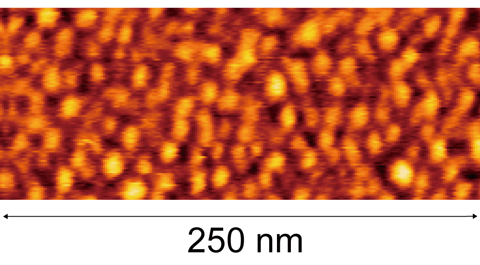Success in Self-Assembly of Quantum Dots with World’s Highest Density
Will Further Accelerate Research toward Realization of High Performance Quantum Dot Devices
2012.06.04
(2012.07.13 Update)
National Institute for Materials Science
The NIMS Photonic Materials Unit is developing an advanced self-assembly technique for semiconductor quantum dots called droplet epitaxy, which is an original NIMS technology, and recently succeeded in the development of a new self-assembly technique for quantum dots with the world’s highest surface density, greatly exceeding the previously reported value.
Abstract
Quantum dots have attracted heightened attention in recent years as a technology for achieving substantial improvement in the properties of semiconductor lasers and development of ultra-high efficiency photovoltaic cells based on a new operating principle. In the newly-developed technology, (1) use of a substrate with a high index surface, (2) formation and crystallization of gallium droplets at near-room temperature, and (3) suppression of the droplet coalescence by optimization of the amount of supplied gallium were introduced in the gallium arsenide (GaAs) quantum dot formation by droplet epitaxy. As a result, the NIMS team succeeded in self-assembly of GaAs quantum dots with an extremely high surface density of 7.3 x 1011/cm2 in a lattice-matched system. The team also discovered that defects originating in crystallization at near-room temperature can be restored by applying ingenuity to the heat treatment process for the crystallized quantum dots, and strong PL emission can be observed from the quantum dots.
Droplet epitaxy has attracted attention as the only method which enables self-assembly of quantum dots in lattice-matched systems, and in principle has the advantage that a large number of high quality quantum dot layers can be stacked in close proximity with maintaining high crystallinity. Therefore, if the ultra-high density in-plane quantum dots developed in this research are stacked in close proximity, it will be possible to produce quantum dot materials with extremely high volumetric density, which cannot be realized with the conventional technology. Thus, it is expected to be possible to achieve higher performance in optical and electronic devices which use quantum dots as a result of this research achievement.
Details of this research were published in the online edition of Applied Physics Letters, which is an American scientific journal in the field of applied physics, and are scheduled for publication in Vol. 100, No. 21 of the print edition.

Fig. :Atomic force microscope (AFM) image of ultra-high surface density quantum dots formed by reducing the amount of gallium irradiation to 3 monolayer at a growth temperature of 30°C. An ultra-high surface density of 7.3 x 1011/cm2 was achieved.
